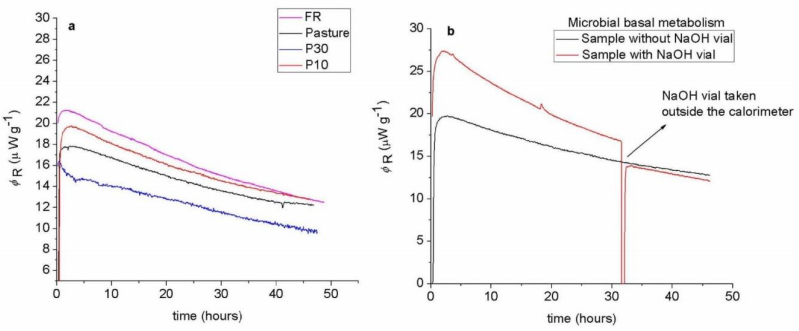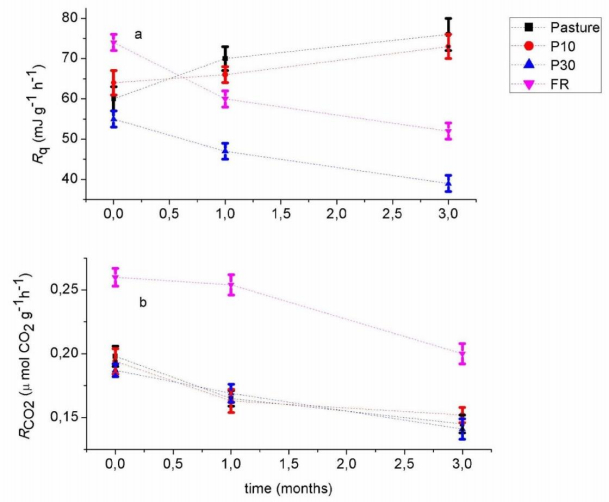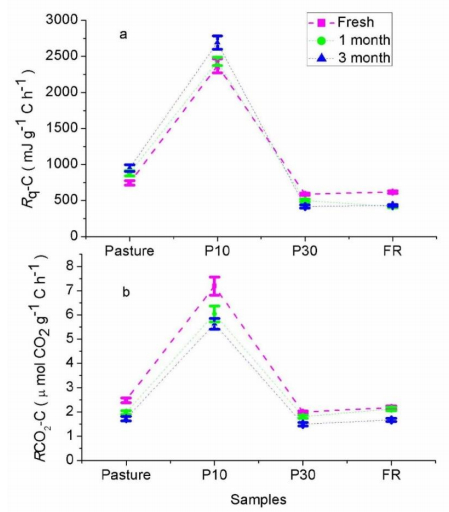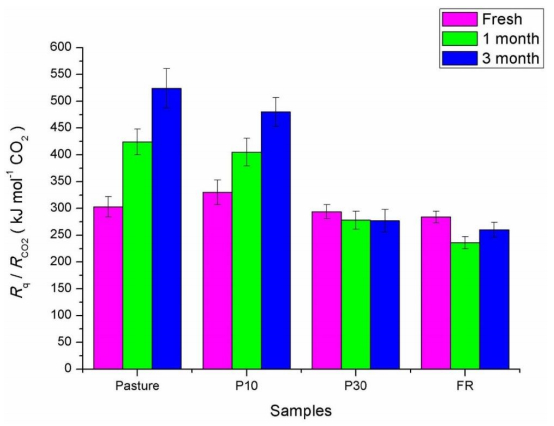Soil samples must usually be stored for a time between collection and measurements of microbial metabolic properties. However, little is known about the influence of storage conditions on microbial metabolism when studied by calorespirometry. Calorespirometry measures the heat rate and the CO2 rate of microbial metabolism, where the ratio of heat and CO2 released, the calorespirometric ratio, informs about the nature of substrates being used by microorganisms. Application to soil microbiology is very recent, and little is known about the influence of the common soil preparation practices between collection and analysis on the calorespirometric measurements. For these reasons, the effect of storage at 4 °C on the microbial metabolism was determined by calorespirometry. Results show CO2 production rate decreases with storage time while the evolution of metabolic heat rate is more stable. The calorespirometric ratio increases with storage time in soil samples with organic matter characterized by lower carbohydrate contribution to the total carbon and higher aromaticity and is unaffected in soil samples with lower carbohydrates in the organic matter and higher aromaticity. Therefore, the calorespirometric ratio values may vary for the same soil sample, such that the soil organic matter properties, as well as the time stored at 4 °C, must be considered in interpreting calorespirometric data on soils.
1.
Introduction
Since Kauffman introduced a binary network called Boolean network (BN) to study the evolution behavior in genetic regulatory networks (GRNs) [1], it has garnered considerable interest from biologists, systems scientists, and others. In a BN, variables are used to represent genes with values of 1 or 0, where 1 implies that the gene is active, and 0 implies that the gene is inactive. When there are external disturbances regulations, BNs are naturally extended to BCNs. In addition, probabilistic Boolean networks (PBNs) and switching Boolean networks (SBNs) are investigated due to the switching and random phenomena in GRNs [2,3].
In fact, BNs (BCNs) with logical function forms are nonlinear networks. Thus, traditional discrete-time linear system theory cannot be used to investigate research problems. Cheng et al. [4] invented the semi-tensor product (STP) of matrices to convert the logical dynamical system into a typical discrete-time linear system. Some methods and ideas in linear system theory can be applied to BNs (BCNs) by using the STP, which further helps scientists analyze and control GRNs for disease intervention [5] or work on feedback shift registers [6] and so on [7,8,9]. Since then, various properties of BNs have been investigated, such as controllability, observability, stabilization and so on [10,11,12,13,14,15,16,17,18,19,20]. Furthermore, as a helpful tool, the STP method also is used in hybrid dynamic systems and fuzzy systems [21,22,23,24,25,26].
In the practical GRNs, the state evolution is complicated and the measuring equipment has limitation [27]. Therefore, it is an effective solution for scientists to measure the output and render the system output to track the desired signals to help study the system's dynamics. It is also of great significance in the application of robots and flight control [28,29,30]. By reviewing the literature, we obtain that the current studies on output tracking issues of BCNs can be mainly divided into the two following categories according to the objectives of output tracking: track a constant reference signal and track a time-varying reference trajectory [27,31,32,33,34,35]. Methods for designing the state feedback control law were described in [27] to let the system's output track a constant reference signal stably after a finite time. In [31], the switching sequence is found by combining the method of set stabilization, so that the SBNs can track a given a given constant reference signal. [32] constructed an auxiliary system to help the outputs of a BCN track the outputs of a reference system. Since it may cost a lot to control over an infinite horizon, [33] considered tracking a given reference output trajectory. In summary, the output tracking problem is an inevitable and crucial issue for GRNs.
In addition, the output tracking problem has other practical significance. For example, the motion of ships carrying heavy cargo needs to track a desired line reserved before, thereby minimizing financial burden [36]. Furthermore, considering that the output tracking research might help control the spread of future epidemics, we mainly care about tracking a given finite length of time-varying reference output trajectory. Moreover, the idea of adding controls to the output is motivated by the research problem investigated in [37]. In the study of a functional system related to avalanche warning, context-alert of context model combined with terrain temperature, snow height, and accelerometer as the total input variables has a specific effect on the output of functional system [37]. Hence, we add controls to the system output to describe these system models. It is worth highlighting that the authors in [33] studied the output tracking problem of BCNs. Nonetheless, the method in [33] fails to solve the problem in some cases. To our knowledge, no study has been done considering the controls in the output to solve the output tracking problem. The system considered in this paper has controls in both state transition and output models. Therefore, to a certain extent, the method discussed in this paper can realize the output tracking problem that cannot be realized in [33]. In the following, we highlight the main contributions of this paper:
● From the perspectives of set and matrix, for the BCN system with output having controls, we give some equivalent conditions to solve the reference trajectory output tracking issue.
● Based on the obtained theorem, the authors construct an algorithm to determine whether the output tracking issue is solvable.
● If the problem can be solved, we develop an algorithm to obtain a feasible control sequence, allowing the system to track the reference output trajectory in a finite range.
The main structure of this paper is as follows. We introduce the preliminaries in Section 2. The main theorems for the solvability of output tracking issues are obtained in Section 3. Finally, some biological examples are proposed to verify our results in Section 4. A concise conclusion is shown in Section 5.
2.
Preliminaries
First, for the convenience of subsequent description, some basic notations are given here.
● D:={0,1}, real numbers are denoted by R and the set of positive integers is denoted by Z+.
● Δq:={δiq|1≤i≤q}, where δiq represents an q-dimensional column vector with the ith element being 1 and others are 0.
● The ith column and ith row of matrix Q are denoted by Coli(Q) and Rowi(Q), respectively.
● We call a matrix Q∈Mm×n logical matrix, if each column vector of it has only one element 1, and the other elements are 0. In this paper, denote the set of m×n-dimensional logical matrices by Lm×n. Besides, Bm×n denotes the set of m×n Boolean matrices, with all elements taking value from D.
● For a logical matrix A=[δi1mδi2m⋯δinm], its abbreviation is A=δm[i1i2⋯in].
● [ϵ,ξ]:={ϵ,ϵ+1,ϵ+2,⋯,ξ}, where ϵ,ξ∈Z+.
● 1k or 0k is the k-dimensional column vector whose elements are all equal to 1 or 0, respectively.
● If α(t)=m1δi12n+m2δi22n+⋯+mkδik2n, where m1,m2,⋯,mk∈Z+, Ξ(α(t)):={δi12n,δi22n,⋯,δik2n}. On the contrary, if one set Ω={δi12n,δi22n,⋯,δik2n}, then Ψ(Ω):=∑kj=1δij2n. To describe concisely, denote Ψ(Ω)=δi1,i2,⋯,ik2n.
● For two vectors ρ=[ρ1ρ2⋯ρs]⊤∈Rs, σ=[σ1σ2⋯σs]⊤∈Rs. We denote the element-wise multiplication of them by
2.1. Semi-tensor product
In this section, we introduce the definition of the STP and how to transform BNs from logical expressions to algebraic forms.
Definition 2.1. [4] For two matrices P∈Ma×b and Q∈Mc×d, the semi-tensor product of them is defined by
where l=lcm(b,c) is the least common multiple of b and c, and ⊗ is the Kronecker product.
When b=c, the STP of matrix is consistent with ordinary matrix multiplication. In this article, we will omit "⋉" without affecting the results to facilitate reading.
Before using the STP to obtain the algebraic expression of BCNs, we show equivalence between Boolean variables and their vector forms. Here, 1 is equivalent to δ12 and 0 is equivalent to δ22.
Lemma 2.1. [4] For a logical function g(x1,⋯,xn):Dn→D, after changing all arguments xi to their vector form xi, i.e., xi∈Δ2, i∈[1,n], it has an equivalent algebraic form g(x1,⋯,xn)=Lgx1⋯xn, where the structure matrix Lg∈L2×2n can be uniquely determined by g.
2.2. Algebraic representation of BCNs
Consider the logical representation of a BCN is abbreviated as
with its output system being
where xi(t),uk(t),yj(t)∈D, i∈[1,n], k∈[1,m], j∈[1,p] are logical variables. gi:Dm+n→D,i∈[1,n], hj:Dm+n→D,j∈[1,p] are logical functions. Then, after changing the logical form of variables to the vector form, we define x(t)=⋉ni=1xi(t)∈Δ2n,u(t)=⋉mk=1uk(t)∈Δ2m. According to Lemma 2.1, we can transform equation (2.1) into
where structure matrices are specified as Mi∈L2×2m+n,i∈[1,n]. Likewise, define y(t)=⋉pj=1yj(t). Then the outputs are
where Nj∈L2×2m+n,j∈[1,p]. Therefore, we can determine the algebraic form of BCN (2.1) and its output (2.2) as
where L, which can be obtained by L=M1∗M2∗⋯∗Mn, is referred to as the network transition matrix. Similarly, H is called an output matrix which can be expressed as H=N1∗N2∗⋯∗Np, where "∗" is the Khatri-Rao product of matrices.
Remark 2.1. Without the loss of generality, in the equations (2.1) and (2.2), the evolution of the state and the output, respectively, in the BCN model we give, is related to the same control sequence. If the state and output are affected by different control variables, we can still combine all the control variables with a dummy matrix [4]. Then, it will make the control sequences the same and larger dimensional than before for the convenience of subsequent studies.
3.
Main Results
3.1. Problem formulation
Based on the above STP work, we can analyze the algebraic form of BCNs to study the output tracking issue. For simplicity, denote a control sequence ut by ut={u(0),u(1),⋯,u(t)}. Thus, the output of the system (2.5) under ut is shown as y(t,x(0),ut). Then, there is y(t,x(0),ut)=Hu(t)Lu(t−1)Lu(t−2)⋯Lu(0)x(0). Since we are investigating the problem of reference trajectory output tracking, there needs to be an assigned reference output trajectory yP:
Next, we will give the definition of reference trajectory output tracking and the solvable conditions for the output tracking issue will be discovered using the properties of BCNs.
Definition 3.1. [33] Consider BCN (2.5) with a given initial state x(0) and a reference output trajectory yP. The (reference trajectory) output tracking issue is solvable, if we can find a control sequence uP such that y(t;x(0),ut)=yo(t),∀t∈[1,P].
We first regard u(t)x(t) in (2.5) as a control-state pair. For convenience of subsequent description, let u(t)=δkt2m, x(t)=δit2n. Then u(t)x(t)=δjt2m+n, where jt=2n(kt−1)+it. For the output yo(t)=δyt2p, the set of u(t)x(t) that can realize output tracking is
We construct sets X(t),Λ(t) and Γ(t) alternatively as shown below to address the output tracking issue, where t∈[1,P].
First, the state set obtained from state x(0) through one step is X(1)={x(1)|x(1)=Lu(0)x(0),u(0)∈Δ2m}. Define the set Λ(t)={˜u(t)x(t),˜u(t)∈Δ2m,x(t)∈X(t)},∀t∈[1,P]. Γ(t) represents the intersection of Λ(t) and Ω(t), i.e.,
It is essential to mention that for t∈[2,P]
Remark 3.1. Ω(t) is the control-state pairs set whose elements can produce the desired output according to H. X(t) is the state set under control sequence which meets the condition of tracking, from the perspective of network transition matrix L of dynamical equation. To unify the dimensions of the two sets, we define the set Λ(t).
3.2. The solvability of the output tracking issue
Following the definition of sets X(t),Λ(t) and Γ(t), a theorem can be obtained to determine the solvability of the output tracking issue from the perspective of the set.
Theorem 3.1. Given an initial state x(0)=δi02n, a positive integer P and a reference output trajectory yP, the output tracking issue of BCN (2.5) is solvable if and only if
Proof. (Sufficiency) For any t′∈[1,P−1], if Γ(t′)=∅, by calculation it has X(t′+1)={x(t′+1)|x(t′+1)=Lu(t′)x(t′),u(t′)x(t′)∈Γ(t′)}=∅. Similarly, it can be obtained that for any t∈[t′+1,P], X(t)={x(t)|x(t)=Lu(t−1)x(t−1)}=∅ always holds. It shows that Λ(t)=∅ and Γ(t)=∅, which is in contradiction to Γ(P)≠∅. Therefore, the condition Γ(P)≠∅ implies that Γ(t)≠∅,∀t∈[1,P]. Then, we can choose a u(P)x(P)∈Γ(P) and denote them by u(P)=δkP2m,x(P)=δiP2n, respectively. Since x(P)∈X(P), there exists u(P−1)x(P−1)∈Γ(P−1), where u(P−1)=δkP−12m,x(P)=δiP−12n, such that Lu(P−1)x(P−1)=x(P)=δiP2n holds. Similarly, we can find a series of control-state pairs {u(1)x(1),u(2)x(2),⋯,u(P)x(P)}, which satisfies u(t)x(t)∈Γ(t) and Lu(t)x(t)=x(t+1),∀t∈[1,P−1]. In addition, for x(0)=δi02n, we only need to determine u(0)=δk02m so that Lu(0)x(0)=x(1). Hence, there exists a control sequence uP={u(0)=δk02m,u(1)=δk12m,⋯,u(P)=δkP2m} such that for any t∈[1,P], u(t)x(t)∈Γ(t), then y(t;x(0),ut)=yo(t) holds. Thus, the solvable goal can be achieved.
(Necessity) If Γ(P)=∅, based on (3.1), we have Λ(P)∩Ω(P)=∅. Then, for any x(P)∈X(P), ˜u(P)x(P) constructed by ˜u(P)∈Δ2m does not belong to Ω(P). Therefore, y(P)=H˜u(P)x(P)≠yo(P), which breaks the requirement that the output tracking issue of BCN (2.5) is solvable. □
Theorem 3.1 shows that ∀t∈[1,P], Γ(t)≠∅ means that there exists u(t)x(t) satisfying both dynamical update condition and output tracking condition. It determines that the output tracking goal of BCN (2.5) can be achieved from the perspective of the set. Next, we consider giving another theorem to realize the goal through vector expression from the perspective of matrix calculation.
Denote
which is the vector form of the set Ω(t) including all the control-state pairs that can produce output yo(t). Define
with γ(0):=12m⋉x(0). Then, we have the following necessary and sufficient criterion for output tracking using vector expression.
Theorem 3.2. Given an initial state x(0)=δi02n and a positive integer P, the output tracking issue of BCN (2.5) is solvable if and only if γ(P)≠002m+n.
Proof. For sufficiency, if there is t1∈[1,P−1], such that γ(t1)=02m+n, then by (3.4), the equation γ(t)=02m+n,t∈[t1+1,P] holds, which is in contradiction with the condition γ(P)≠02m+n. Thus, it concludes that γ(t)≠02m+n,t∈[1,P]. For γ(P)≠02m+n, we can take u(P)x(P)=δjP2m+n∈Ξ(γ(P)), and denote them by u(P)=δkP2m,x(P)=δiP2n, respectively. According to the construction of γ(t) in (3.4), it implies that y(P)=Hu(P)x(P)=yo(P). Then, we can choose u(t−1)x(t−1)∈Ξ(γ(t−1)) satisfying that Lu(t−1)x(t−1)=x(t)=δit2n, where u(t−1)=δkt−12m,x(t−1)=δit−12n,t=P,P−1,⋯,2. It also holds that y(t)=Hu(t)x(t)=yo(t). For t=1, u(0) is determined by satisfying Lu(0)x(0)=x(1)=δi12n. Hence, there is a uP={u(0)=δk02m,u(1)=δk12m,⋯,u(P)=δkP2m} so that ∀t∈[1,P], y(t;x(0),ut)=yo(t) holds, which means that there is one way that the output tracking goal of BCN (2.5) can be resolved. As for necessity, it is removed here since it is analogous to Theorem 3.1.
□
Theorem 3.1 gives the necessary and sufficient conditions for the solvability of output tracking problem from the set viewpoint, which helps us to understand. In Theorem 3.2, the criterion is given by vector method, which is convenient for practical calculation and judgment. Then, Algorithm 1 is given below to illustrate the general steps for determining whether the output tracking issue can be solved.
3.3. Tracking control design
After we investigate whether the output tracking issue for a reference trajectory in a given finite time can be solved, we consider finding a control sequence satisfying the condition that BCN (2.5) is solvable, such that the outputs can achieve the given reference output trajectory.
The basic idea to solve the problem is to calculate u(t) and x(t) backward by γ(t), t∈[1,P]. Obviously, the control-state pairs that can realize output tracking may be not unique at each time, and our goal is to find a feasible control sequence so that the output trajectory can track the reference output trajectory. Algorithm 2 gives the design method of the controllers.
Remark 3.2. It is worth to note that Algorithm 2 is based on the Algorithm 1. We need to calculate all γ(t), t∈[1,P] and determine that γ(P)≠02m+n. Therefore, Step 3 in Algorithm 2 is a way to select the feasible control u and x. Finally, the control sequence that can achieve the output tracking is determined based on the γ(t), t∈[1,P], calculated in Algorithm 1.
Furthermore, it has been proved that solving control problems of BCNs using the STP is an NP-hard problem and causes exponential computational burden. In particular, the worst-case computational complexity involved in determining the problem's solvability (Algorithm 1) is O(2nP), and designing the control sequence (Algorithm 2) is O(2n+mP).
Proposition 3.1. Given x(0)=δi02n, under the control sequence {u⋇(0),u⋇(1),⋯,u⋇(P)} obtained in Algorithm 2, the state trajectory {x⋇(1)=δi12n,x⋇(2)=δi22n,⋯,x⋇(P)=δiP2n} will produce the desired reference output trajectory yP.
Proof. From Algorithm 2, we can find that
For any t∈[1,P], there is
Since u⋇(t)x⋇(t)∈Ξ(γ(t)) holds for all t∈[1,P], it implies that u⋇(t)x⋇(t)∈Ω(t). Therefore, it can be obtained that y(t)=yo(t),∀t∈[1,P].
□
In daily life, constraints are everywhere. Taking the treatment of patients by doctors as an example, the state of patients or cells can be regarded as the state of the system, and the prescription drugs issued by doctors can be regarded as the control of the system. The purpose of doctors' treatment of patients is to hope that patients will enter a continuous healthy state, so some unhealthy and sick states should be avoided [38]. In some cases, the type of drugs will be determined according to the state of the patient. For example, when the patient is in the state of drinking alcohol, the doctor will not consider taking cephalosporin anti-inflammatory drugs, which is the transition constraint considered here [39]. In addition, if some drugs were developed a long time ago, and with the increase of medical level, we find the use of these drugs may have undesirable side effects on the human body, then doctors will not consider prescribing these types of drugs. For example, furazolidone as an effective drug, is usually used to treat gastrointestinal diseases such as dysentery and enteritis caused by bacteria and protozoa. However, scientists found that it has potentially carcinogenic properties [40]. Hence, doctors won't use compound preparation containing furazolidone now, and it can be one of the examples for the input control constraints. Therefore, in controllers' design, we should also consider changes in state, transition and input constraints.
(1) State constraint
When solving the output tracking issue of the system and designing the controllers, if a state x(t)=δi2n should be avoided, then the ith row of matrix L should be
At this point, we do not consider any transition from other states to x(t)=δi2n.
(2) Transition constraint
In a BCN, a transition constraint forbids the control input u(t) for a state x(t). For example, if the transition from the state x(t)=δi2n using control input u(t)=δk2m is forbidden, then we have
(3) Input constraint
The input constraint means there are some controls that we cannot take. Suppose that u(t)=δk2m has to be forbidden, then the k-th block of L and H will be null matrices, that is
4.
Example
Example 4.1. Consider BCN in [33]:
This is a simplified BCN model of lac operon in Escherichiacoli. Applying the STP method, the following algebraic form can be obtained:
where x(t)=⋉3i=1xi(t)∈Δ8, u(t)=⋉3k=1uk(t)∈Δ8, y(t)=⋉2j=1yj(t)∈Δ4. Besides, the network transition matrix and the output matrix are
At the beginning, we assume that x(0)=δ28, and give two reference output trajectories as:
To better simulate the GRNs, we assume that there are three types of constraints in (4.2):
(1) State constraint: State δ18 should be avoided, which means that Row1(L)=00⊤64.
(2) Transition constraint: For state x(t)=δ68, it is prohibited to use control input u(t)=δ38. Then, the two matrices become L3=δ8[88888088], H3=δ4[22222022]. With a slight abuse of notation, we use δ0i here to represent 00i.
(3) Input constraint: Considering the specification about the concentration of extra cellular lactose, the control input u=⋉3k=1uk=δ28 and u=⋉3k=1uk=δ68 are forbidden. Then, we have L2=L6=008×8, H2=H6=004×8.
Under the three types of constraints, the new matrices are expressed as
The following is to determine whether the output tracking issue can be solved for the given output trajectories 1 and 2. If it is solvable, we can give the corresponding controllers' design. Initialize γ(0)=118⋉δ28, and it has γ(0)=δ2,10,18,26,34,42,50,5864 by calculation.
We first consider whether the system can track the specified reference output trajectory 1.
(1) For yo(1)=δ24, according to ˆH, we can get Ω(1)={δ1764,δ1864,δ1964,δ2064,δ2164,δ2364,δ2464,δ2564,δ2664,δ2764,δ2864} and w(1)=δ17,18,19,20,21,23,24,25,26,27,2864. Then, we have
(2) For yo(2)=δ34, we have Ω(2)={δ5364,δ5464,δ5564,δ5664,δ6164,δ6264,δ6364,δ6464} and w(2)=δ53,54,55,56,61,62,63,6464. Then, it holds that
(3) For yo(3)=yo(4)=δ44, it holds that Ω(3)=Ω(4)={δ2964,δ3064,δ3164,δ3264}, and w(3)=w(4)=δ29,30,31,3264. Furthermore, we have
It can be concluded that the output tracking issue of the system is solvable for reference output trajectory 1 since γ(4)≠008. Then, we can use the method in Algorithm 2 to find a feasible control sequence to realize output tracking for the output trajectory 1. The specific process is as follows. First, since P=4 and γ(4)=14δ3264, we can only get that u⋇(4)x⋇(4)=δ3264∈Ξ(γ(4)). Hence, by decomposition, we have u⋇(4)=δ48 and x⋇(4)=δ88. Next, we need to choose u⋇(3)x⋇(3)∈Ξ(γ(3)), satisfying ˆLu⋇(3)x⋇(3)=x⋇(4)=δ88. Then, we have u⋇(3)x⋇(3)=δ3264 with u⋇(3)=δ48 and x⋇(3)=δ88. Similarly, we can obtain a control input sequence that meets the output tracking condition represented by {u⋇(0)=δ18,u⋇(1)=δ38,u⋇(2)=δ78,u⋇(3)=δ48,u⋇(4)=δ48}, with corresponding state sequence denoted by {x⋇(0)=δ28,x⋇(1)=δ88,x⋇(2)=δ88,x⋇(3)=δ88,x⋇(4)=δ88}. Note that this is only a feasible situation we have proposed, and it is not unique.
Analogously, for reference output trajectory 2, we can obtain that
It determines that the system can track reference output trajectory 2 since γ(4)≠008. Furthermore, the input sequence that meets the output tracking condition can be {u⋇(0)=δ18,u⋇(1)=δ78,u⋇(2)=δ38,u⋇(3)=δ48,u⋇(4)=δ48}.
In [33], there does not have any control in the output system. The system can realize output tracking under output trajectory 1, but fails under output trajectory 2. As one of the innovations of this paper, we add control input to the output system. We can find in this example that it makes the system realize output tracking under two reference output trajectories.
Example 4.2. Consider a modified lactose operon model in Escherichia coli with 5 nodes [41]:
Based on the STP method, we can transfer the model to the form as (2.5) with x(t)=⋉5i=1xi(t)∈Δ32, u(t)=⋉2k=1uk(t)∈Δ4, y(t)=⋉2j=1yj(t)∈Δ4, where L=δ32[131317192123⋯2626262830303032] and H=δ4[11111111⋯44444444]. Next, we suppose that there are some constraints:
(1) State constraint: State δ3232 is avoided and Row32(L)=00⊤128.
(2) Transition constraint: For state x(t)=δ332, the control input u(t)=δ14 is limited, so we will have Col3(L)=0032,andCol3(H)=004.
(3) Input constraint: Suppose that the control input u=⋉2k=1uk=δ24 is forbidden. Finally, the matrices are changed to ˆL=δ32[130317192123⋯262626283030300] and ˆH=δ4[11011111⋯44444444].
Here, we are going to check under the condition that the initial state is x(0)=δ2032, whether the output tracking issue can be solvable with the given output trajectory yo(1)=δ14,yo(2)=δ24,yo(3)=δ14. First, according to Algorithm 1, it has γ(0)=114⋉δ2032=δ20,52,84,116128. Then, calculated by the while loop, we can obtain γ(1)=δ11,27,28,43,59,60,75,91,92,107,123,124128,γ(2)=δ105,107128,γ(3)=2δ17128. It shows that the output tracking issue of BCN (4.3) is solvable. Hence, we can use Algorithm 2 to get a feasible control sequence such that BCN (4.3) achieves output tracking.
First of all, because of γ(P)=γ(3)=2δ17128, it can be divided to u⋇(3)x⋇(3)=δ14⋉δ1732. Then, we aim to choose u⋇(2)x⋇(2)∈Ξ(γ(2)) such that ˆLu⋇(2)x⋇(2)=x⋇(3)=δ1732. By calculation, it obtains u⋇(2)=δ44,x⋇(2)=δ932. Furthermore, we can get u⋇(1)=δ14,x⋇(1)=δ2732 and u⋇(0)=δ34. Therefore, using the control sequence {u⋇(0)=δ34,u⋇(1)=δ14,u⋇(2)=δ44,u⋇(3)=δ14}, the output tracking issue based on the given reference trajectory can be solved.
5.
Conclusions
By using the STP, for the BCNs with controls in output, the reference trajectory output tracking issue is investigated. Some results to solve the output tracking issue are proposed and an algorithm is designed to judge the solvability. Moreover, the controllers' design algorithm is given by calculation when we have determined that the output tracking issue is solvable. To better apply the results to daily life, the corresponding changes in the network transition matrix and output matrix under some constraints simulated from reality are considered. In the end, the effectiveness of our results is shown by some examples. An important direction for future research is to investigate output tracking problem by reinforcement learning method. In addition, we can study the problems considered in this paper in BNs with time delay or switching signal.
Acknowledgment
This work was jointly supported by the Natural Science Foundation of Zhejiang Province of China under Grant Nos. LR20F030001 and LD19A010001, and the National Natural Science Foundation of China under Grant 62173308.
Conflict of interest
The authors declare that they have no known competing financial interests or personal relationships that could have appeared to influence the work reported in this paper.









 DownLoad:
DownLoad:







